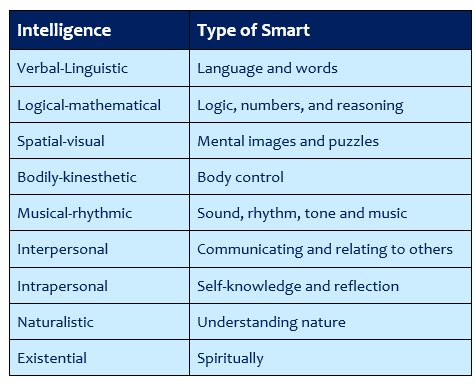Multiple Intelligences in the Classroom
The Theory of Multiple Intelligences was developed in 1983 by Dr. Howard Gardner. His theory suggests the traditional concept of intelligence, based on I.Q., is too limited and restrictive. Gardner believes people possess multiple types of intelligence, not just words and mathematical intelligence. He proposes there are at least eight or nine different intelligences that account for a broader range of human potential.
These intelligences are:
Implications in the classroom
The traditional formal educational system is heavily biased toward a narrow set of methods of instruction and assessment. Most schools focus almost all of their attention on linguistic and mathematical intelligence, and neglect the other types of intelligence.
Dr. Gardner believes educators should also place value on individuals who show gifts in the other intelligences. He believes educators need to integrate other methods and modes of learning to include all areas of intelligence so equal learning opportunities are provided to all types of learners. This would include using collaboration, music, drawing, multimedia, reflection, and other engaging methods.
How They Learn Best
Below are some ways to reach other intelligence type in the classroom.
Verbal-Linguistic
Verbal-Linguistic intelligence is the ability to use language and words to express one’s thoughts.
Instructional activities for individuals with high Verbal-Linguistic intelligence:
- reading books and magazines
- playing word games
- writing poetry
- writing scripts or stories
- giving a speech
- making videos
- designing a brochure
Logical-Mathematical
Logical-Mathematical intelligence is the ability to detect patterns, reason deductively, and think logically.
Instructional activities for individuals with high Logical-Mathematical intelligence:
- problem solving
- programming computers
- using spreadsheets
- experimenting with new information
- playing logic games
- conducting investigations
- unraveling mysteries
- conducting a survey
- graphing or charting the results
- debating ideas
Visual-Spatial
Visual-Spatial intelligence is the ability to create internal mental images and think in pictures and three dimensions.
Instructional activities for individuals with high Visual-Spatial intelligence:
- drawing pictures
- making posters
- creating diagrams, graphs, and charts
- creating colorful designs, patterns, and pictures
- engaging in active imagination
- using visualization guided imagery
- developing models
- creating videos
- taking photos
- creating animation in PowerPoint
- developing web page
Bodily-Kinesthetic
Bodily-Kinesthetic intelligence is the ability to use one’s body in a skilled way by coordinating bodily movements.
Instructional activities for individuals with high Bodily-Kinesthetic intelligence:
- expressing themselves through body language
- creating interpretive dance
- hands-on learning
- acting out a concept
- playing charades
- role playing
- writing on the whiteboard or smartboard
- acting out a skit
- building a model
- creating a collage
Musical-Rhythmic
Musical-Rhythmic intelligence is the ability to recognize and compose musical pitches, tones, and rhythms.
Instructional activities for individuals with high Musical-Rhythmic intelligence:
- creating songs about a subject
- playing music in the background
- turning lessons into lyrics
- speaking rhythmically
- creating cd’s
- creating podcasts
Interpersonal
Interpersonal intelligence is the ability to understand and interact effectively with other people.
Instructional activities for individuals with high Interpersonal intelligence:
- performing group activities
- working in teams
- interacting in debates
- having class discussions
- conducting seminars
- letting them teach the class
- interacting with others via social media
Intrapersonal
Intrapersonal intelligence is the ability to understand oneself and one’s thoughts and emotions.
Instructional activities for individuals with high Intrapersonal intelligence:
- allowing for self-reflection
- creating memoirs or diaries
- writing in journal
- blogging
- meditating exercises
- creating situations that cause introspection
Naturalistic
Naturalistic intelligence is the ability to understand living things as well as sensitivity to other features of the natural world.
Instructional activities for individuals with high Naturalistic intelligence:
- getting involved in nature and the natural world
- conducting class outdoors
- going on field trips
- collecting and classify natural items like rocks and plants
- using natural items as math manipulatives
- visiting aquariums, farms, botanical gardens, and zoos
- going on nature walks
- visiting museums
- creating classroom gardens
Existential
Existential intelligence is the ability to tackle deep questions about human existence.
Instructional activities for individuals with high Existential intelligence:
- pondering the meaning of life
- getting involved with special causes
- working with charity groups
- volunteering for community service
- journal writing
- group discussion
Related Links
Multiple Intelligences in the Classroom
Theory of Multiple Intelligences


